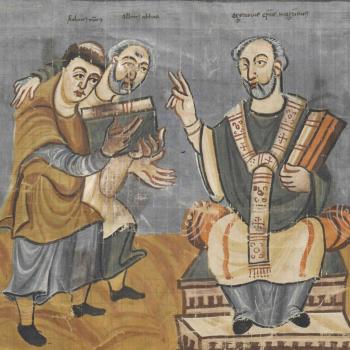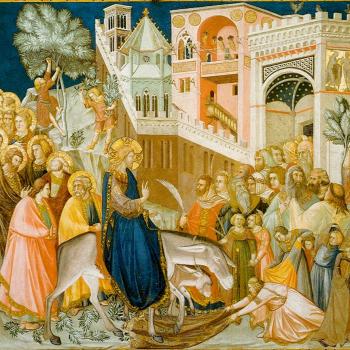This post concerns an authentically frightening figure in US history, and one whose career speaks powerfully to contemporary debates about religious and ethnic prejudice. If our history had traveled in somewhat different directions, he might have become very powerful indeed. Be very grateful that you have never heard of Paul Meres Winter.
A hundred years ago, anti-immigrant sentiment in the US was ferocious, and it was intimately linked with religious zeal. A great many mainstream Protestants were passionately anti-Catholic, seeing immigration from south and east Europe as a Trojan Horse to subvert traditional “real” America. That feeling was at the core of the revived Ku Klux Klan of the 1920s, with its several million members: its Protestant character was overwhelming, and in fact its unofficial anthems were The Old Rugged Cross and Onward Christian Soldiers. That story is well-enough known (if often forgotten) but we pay less attention to where some of that bigotry went ideologically after the Klan imploded. Paul Winter shows how anti-Catholic and anti-immigrant bile transformed into outright Nazism. And by Nazi, I don’t mean “outspoken if tasteless conservative,” I mean real hard-core, swastika-waving, Hitler-loving Nazism, right here on these shores.
I first came across Paul Winter some twenty years ago when I was writing my book Hoods and Shirts, about the extreme Right in Pennsylvania between 1918 and 1945. The title is significant, as the book traced the relationship between the hooded Klan and the various far Right movements of the 1920s onward, with their characteristic “shirt” uniforms and symbolism (Fascist Black Shirts, Nazi Brown Shirts, occult-minded Silver Shirts, and a great many others). Paul Winter perfectly exemplified this continuity.
Winter was a leader of the very powerful Philadelphia Klan, which at its height claimed some fifty thousand members in the metropolitan area. He was one of the movement’s most effective publicists and evangelists, but he was also deeply involved in factional struggles. In a striking portent of his later political allegiance, Winter earned notoriety by forming a personal elite bodyguard and enforcement squad known as the Super-Secret Society, the “S. S. S.” (at this early date, the similarity of name to the German S. S. is coincidental. And no jokes, please, about Double Secret Probation). The “Night Riders” of this “Black-Robed Gang” beat and intimidated opponents who questioned Winter’s shady financial dealings. Winter’s tactics included exposing the Klan membership of his opponents, seeking thereby to attract boycotts and demonstrations against them by Catholics and other hostile groups. His critics accused him of “building up a far more autocratic organization than Rome ever dared to build.” In 1925-26, the Philadelphia Klan’s klaverns (lodges) were riven by violence, lawsuits, and spectacular mutual expulsions.
In 1928, the Klan nationwide was galvanized anew by the threat of a Catholic Presidential candidate in the form of Al Smith. In that year, Winter published in his What Price Tolerance? (Hewlett, N.Y.: All-American Book, Lecture and Research Bureau, 1928) a comprehensive statement of anti-Catholic ideology. The book gives an excellent idea of the kind of rhetoric used by Klan leaders in their speeches intended to recruit new members, and to fire up supporters.
For Winter, Catholic “aggression” was expressed in the Catholic marriage laws, which denied the validity of Protestant marriage and family life, and in the sectarian schools, which created and sustained a whole alternative society and cultural life. Surging Catholic power threatened to overwhelm American society and values. In the previous century, the Church in the United States had grown from fifty thousand adherents and 35 priests to twenty million faithful with a vast network of clergy, schools, and seminaries. By the 1920s, there was a “general staff” – perhaps a provisional government? – in the form of the elaborate bureaucracy of the National Catholic Welfare Council. The nightmare was that all Americans would someday be subjected to this tyranny, and that a Catholic would someday attain the presidency. Catholic strength was founded on “Alienism”, “the unassimilated hordes of Europe”, which threatened American racial purity.
Soon, warned Winter, an apocalyptic struggle would commence between “traditional Americanism and the religious and political invasion of the United States by the champions of European institutions and ideals.” “America’s Armageddon” would be physical as well as moral, as Catholics had so often showed themselves the masters of subversion and conspiracy. In Philadelphia itself, the new church of St Charles Borromeo (on South 20th Street) was being built with very thick walls that appeared suitable for fortification. Was a Catholic coup d’etat imminent?
Do I really have to point out each and every parallel between Winter’s conspiracy theories then and anti-Islamic themes today? Do particularly note the inextricable mixture of religious and racial prejudices.
Against the clear Catholic menace to the republic, said Winter, patriotic forces were stirring. That naturally included the Klan, but also a number of other groups that collectively comprised what he terms “American Nationalism”. This coalition included faithful Protestant clergy untainted by ecumenical temptations, and the network of fraternal and patriotic orders, most powerfully the Freemasons.
Winter’s world view is founded on a stark conflict between “American Nationalism” and the conspiracies of “Political Romanism”, which also involve “alienism, Bolshevism, internationalism, political debauchery and lawlessness.” American democracy was under threat from the machinations of the “three international capitals – Rome, Moscow, and Wall Street”, though even here the sin of Wall Street is that it is pro-Catholic, rather than subservient to Jewish interests.
Already in 1928, Winter was well versed in racial theories. Both he and his movement are “Nordic”, and therefore opposed to “anything emanating from the Latin countries.” “America is fundamentally Nordic and Anglo-Saxon,” and as such needed to rediscover the Nordic heritage concealed by the Catholic historians. This land is in truth America, Amt-Erica, the land found and named by the Viking Eric the Red, rather than the Latin Catholic impostor and plagiarist Columbus.
Fortunately for its enemies, the Klan was a deeply unstable and fractious organization, which often fell into violent internal feuds, commonly over matters of money and rumored embezzlement. By the 1930s, Winter was expelled from the remnants of the Philadelphia Klan, but he found a new and dangerous career as a Nazi propagandist and (possibly) even an active German agent. He moved to Shavertown in Pennsylvania’s Luzerne County, near Wilkes Barre, where he led the Klan’s klavern #311 “Rescue.” He was the prime mover of the anti-Semitic “Civil Intelligence Bureau” reported active there in 1940.
There is a striking portrait of the Shavertown circle in the exposé book Under Cover, published in 1943 by “John Roy Carlson,” the pseudonym of an Armenian-American journalist named Arthur Derounian. From 1939 onwards, Derounian posed as an anti-Semitic reporter and organizer in order to infiltrate ultraright groups. He spent four years under cover testing the scale and seriousness of the militias, and he met many zealots who openly espoused armed conflict. Let me say right away that Derounian should not be trusted on every word he writes, as he was so committed to making the people he denounced look as actively dangerous and terroristic as possible. He exaggerated and rumor-mongered. But he certainly was accurately characterizing the kind of rhetoric that prevailed in these far Right circles. You can confirm this from their own published writings, not to mention from plenty of surviving letters and maunscripts that were originally intended to be confidential.
While under cover, Derounian interviewed Winter, “a Legionnaire . . . and distributor of Nazi pamphlets direct from Berlin.” Winter was at the center of a widespread network of extremists. His closest political associates included Edwin Flaig, a German who lived at Millvale near Pittsburgh. Flaig claimed personal acquaintance with Hermann Göring, Wilhelm Frick, and other Nazi leaders. A flagrant anti-Semite, Flaig had attended Hitler rallies in Germany, and looked forward to the day when Hitler would use mustard gas against New York City. Flaig reputedly was involved in gun-running, and boasted of the existence of armed Nazi groups in the Pittsburgh area, often disguised as rifle or sporting clubs. After all, he claimed, “Jew-hunting is going to be pretty good soon, and we are practicing.” “The boys” would “dynamite Detroit, Pittsburgh, Chicago – paralyze transportation and isolate whole sections of the country . . . A blood bath is the only way out.”
Before rejecting these claims as windy fantasy, it is worth recalling that in January 1940, the FBI did arrest the leaders of a controversial ultra-Right movement called the Christian Front, which allegedly was plotting widespread attacks in major US cities, under cover of rifle clubs. Again allegedly, they planned to wage guerrilla warfare on American cities, and they claimed friends and allies in government and the military. They aimed, in one reporter’s words, to ”bomb selected buildings, seize public utilities, blast bridges, terrorize Jews, appropriate Federal Reserve gold, assassinate fourteen Congressmen, and set up a dictatorship.” A sensational trial followed, although the government could not prove its case. Do check out the related image here.
Another Winter friend was James B. True, whom Flaig reported meeting at Shavertown in 1939, and who had bought some of Flaig’s weaponry. True was an anti-Semitic fanatic of national reputation, who denounced “the Jew Communism which the New Deal is trying to force on America.” He attempted to patent a type of billy-club under the title of Kike Killers, and published the anti-Semitic news-sheet, Industrial Control Reports. He wished “to return the United States from a Talmudic dictatorship to its original republican form of government.” True warned of the millions of European Jewish refugees (“refujews”) waiting to flood into the United States to steal American jobs and homes.
Winter and True were both close to Robert E. Edmondson, publisher of the American Vigilante Bulletin. Like most members of this circle, Edmondson believed that Roosevelt was a Jew, who had initiated his “Jew Deal.” Edmondson was originally based in New York City, but in 1939 his Edmondson Economic Service moved to the remote Luzerne county community of Stoddartsville, from which he published his American Vigilante bulletins. This choice of refuge is difficult to explain without assuming that he wanted to be close to Winter.
Edmondson, incidentally, was an inspiration to the latter day anti-Semite William L. Pierce, who among other things wrote the notorious Turner Diaries, the inspiration for much later terrorism. The Oklahoma City bombing of 1995 closely followed a script laid down in the Turner Diaries.
The activities of Winter and his friends would have been unsavory at the best of times, but they were deadly dangerous as the country prepared for possible war with Hitler. In 1940 and 1941, the Pennsylvania Klan itself was deeply divided between pro- and anti- Nazi factions. In the Rescue klavern in Wilkes-Barre, pro-Germans like Winter confronted more moderate ultra-patriots and ultra-conservatives, and each side tried to purge its enemies. As Winter’s enemies protested, “In every speech he delivered, he showed favoritism for Germany. We feel that our favorite is and should be the United States of America. He claims too that the United States is his first love, but he certainly does not show it . . . [he] has boasted to at least two of our members that he belongs to a German organization whose headquarters are in Germany.”
Religious bigotry evolved neatly into outright Nazism. And yes, to adapt Sinclair Lewis’s book title: it really did happen here.
I’ll say more about this in my next post.















